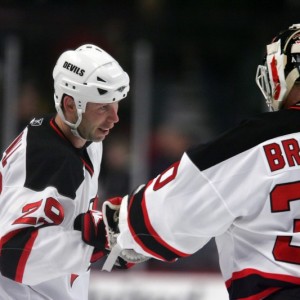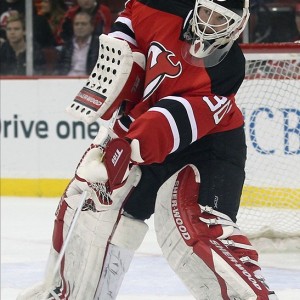Martin Brodeur will have his jersey sent to the rafters on Tuesday night, when the organization where he spent parts of 21 seasons retire his jersey. For fans–this one in particular–it reminds me of the weird, sometimes bitter arrival to the sport of hockey and how much of it was number 30’s doing.
I guess you could say I found hockey kind of on accident.
I was already ten the time I first started to watch and appreciate hockey. I was in the third grade and was, for the first time in my short life, about to see the often-maligned New York Mets compete in a World Series. Their opponent: the New York Yankees. The story was simple–they won (a lot) and we lost (a lot). When the Yankees defeated the Mets in five games to capture their 26th championship, it was my first realization that David can’t beat Goliath.
I had developed a passionate distaste for New York sports teams (except the Mets). They always seemed to be the front page of the sports section or the headliner on the news. I remember being so excited when Toms River, New Jersey’s little league team, who had won the Little League World Series two years prior, were on the Rosie O’ Donnell Show. But other than that, I could always remember that second-fiddle feeling.
Not New York
Nothing boiled my blood more than the NFL, where two (2) franchises played in New Jersey, but bared the ‘N.Y.’ crest. It reminded me of all the great atrocities on the Garden State–the Statue of Liberty, in N.J. waters, but perhaps the most synonymous image of New York. Constant references to the state as the ‘little brother’ or less affectionately, the ‘armpit.’
Maybe it was because I grew up in a baseball house, but hockey was always background noise. I was at a family party earlier in the summer of 2000, when in the late hours of the night, waiting for my brothers to get out of the pool, I saw Jason Arnott be tackled by a ton of players. I knew it was a celebration, but wasn’t entirely sure of what had exactly happened. My brothers got out, and I left to go home with my family. The Devils had just won their second Stanley Cup, but I left.
Fast forward back to game five of the 2000 World Series (rather, the Friday following): Coming into school as one of the lone Mets’ fans in a sea of Yankees caps, t-shirts and jerseys was gut-wrenching. It was the rich getting richer. Those who didn’t follow baseball or have any fresh Yankees gear would throw on their Giants’ jackets–some would unzip their jacket to reveal more Yankee memorabilia. Some already had the “26-time champions” ones. And there I was, probably wearing some shirt with a Disney character on it. Let’s say it was Donald Duck, because that would most accurately reflect my mood.
Discovering Hockey
I was fed up. I didn’t want anything to do with baseball. I only stomached football as it was, so it was mostly a stalemate of what belongs to who–based on where. So, I turned back with curiosity to that group of guys who four-five months earlier were jumping all over each other at the end of what could only be, the happiest moment I had seen in sports to date. It was the New Jersey Devils. It was hockey, and for once, it wasn’t muted or background noise. I became heavily invested.
In the years that followed, I became entrenched with the Devils and hockey. It was fast, there were goals (sometimes) and hitting and fighting. It combined everything all my friends at school would talk about with football, soccer and wrestling–only I thought it was better.

The icing? The Devils won…a lot and at the highest level. Meanwhile across the Hudson, the Rangers’ Yankee approach to free agency rarely yielded results, and the Islanders laughable operations were not unlike the Mets, who wore the same blue and orange. It was actually funny from afar. From 1997-98 to 2003-04, the Devils won 318 games. The Rangers and Islanders won 215 and 214, respectively.
If that 100+ win differential didn’t tell the tale of New Jersey’s supremacy over the metro-area hockey story, then perhaps the three cups in nine years, four appearances in that same span and five division titles from 1994 to 2004.
Face of a Franchise
Longtime general manager Lou Lamoriello was instrumental to that success, that helped create one of the model organizations in pro sports, through the assembly of a roster, able to compete for something year in and year out. Perhaps no player was more emblematic of the team philosophy than Martin Brodeur.
The goaltender, who worked his way up from his 1990 draft (20th overall) became the face of the organization–one not shared or treasured by New York, but New Jersey. He promptly set records, that appear unbreakable and collected hardware, though none more important to him than the three Stanley Cups. In a state whose fan base often borrowed New York’s teams for their rooting interest, there was finally something–someone to call our own.
Brodeur will be among the Derek Jeter, Mariano Rivera in the category of one of the best to play the game at his position. His ability with the puck has been emulated by goaltenders in the league today, and will continue to be. His skill set even prompted a new rule, the trapezoid, an area behind the net in which goaltenders can play the puck. A change from before when all areas behind the blue line was fair game, and used quite frequently by the Devils in their attack.
Even with the post-2004 rule changes, Brodeur still won–a lot. Even after not playing anywhere for the locked-out 2004-05 season, Brodeur responded to the new NHL with three-straight 40-plus win seasons and two of his four Vezina trophies. The following season, after missing time with his first significant injury in 2008-09, he achieved records for wins (552) and shutouts (104).

The final five-plus seasons of Brodeur’s career were the begin of his decline, though he still managed a .916 save percentage and 45-win season at age 37 in 2009-10, earning his fifth Jennings trophy.
His final highlight was helping backstop a surprise Devils team in 2011-12 go on a run to the Stanley Cup finals, Brodeur’s fifth appearance. He allowed five goals on 24 shots in the Devils’ game six loss to the Kings to fall four games to two in the finals. It was the last playoff game of Martin Brodeur’s career.
The final three years would bare witness to some unusual sightings–among them, a return to the role as a back up for the first time in nearly 20 years and most unusual–a new jersey, a seven-game stint with the St. Louis Blues, where he now serves as the team’s assistant general manager.
Cementing an Era
Through that time though, a career emerged, one defined by professionalism and excellence. It was essentially, what the Devils stood for. Which only makes his banner joining Scott Stevens, Ken Daneyko and Scott Niedermayer all the more bitter-sweet.
While the four help showcase the history that belongs exclusively to New Jersey and the Devils, it also is a reminder of years gone by, a new era and hopefully one that will unite the state with its only professional team.
Brodeur will be immortalized by both a statue and his number high above inside Prudential Center, but it’s also a reminder to me of the state’s lone sports icon that belongs exclusively to them.